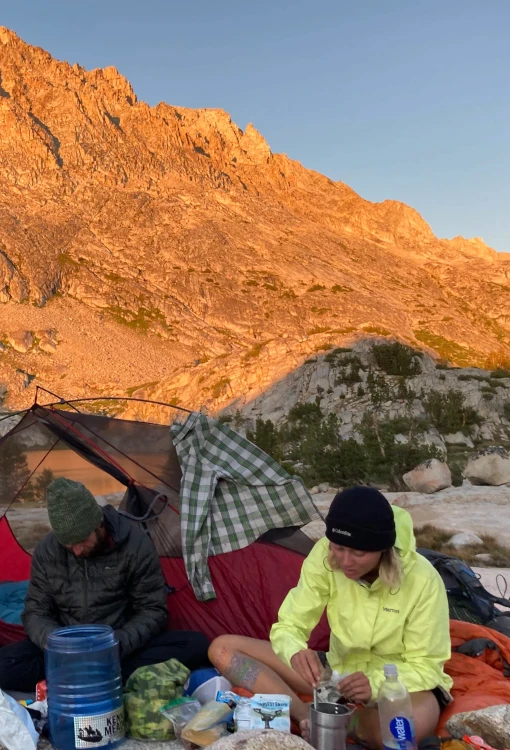
RESUPPLYING = RESTOCKING PROVISIONS WHILE BACKPACKING.
The Vital Art of Resupplying in Long-Distance Backpacking
THE BACKPACKER’S LIFELINE
Picture this: You’re in the middle of the wilderness, miles away from civilization, and it’s time to resupply. You eagerly open your resupply box, only to discover that you’ve packed enough dehydrated mashed potatoes to feed a small army, and your friend’s resupply package is nothing but a large array of candy bars.You didn’t plan ahead and just kind of threw things together before you left for trail. Food fatigue sets in, and you’re not as motivated to eat what you’ve packed yourself.
Welcome to the chaotic (and sometimes overwhelming) world of resupplying.
While all trips are filled with excitement of the unknown, stories you’ll be able to tell years down the road, and strategic planning to ensure your safety while sauntering along trail. A longer jaunt out in the woods like a thru-hike or section hike will leave you with a little more planning involved than a typical weekend trip.
Thru-hiking and section hiking are different from other backpacking trips in that you have multiple sections of trail that you’re moving through which requires a little more planning when it comes to resources like food. A typical backpacking adventure lasts 2-5 days, all items are packed in and out while being in the backcountry and by the time the trip is done it’s time to be back in normal society with a nice meal and a hot shower.
In contrast, depending on what section or trail you’re hiking, a section or thru-hike can amount to 10-30 backpacking trips conjoined together without the opportunity to go home and refill your needs. Since you’re permanently out on trail it’s important to be a little creative with how to regain the provisions that were eaten and used- this goes into the art of resupplying.
SO, WHAT DOES IT MEAN TO RESUPPLY?
The act of resupplying means to restock provisions that are used while backpacking. This can go by many different means. A typical trail will have points along each section where you can hitch-hike or walk into towns full of fresh food or pick up a package that was previously sent. While in town the number one priority is to fill your pack with food that will give enough calories, nutrients, and diversity to keep you properly fueled and energized enough to complete your hike.
When you’re weeks into a long-distance hike, fatigue sets in, and the monotony of trail life can take its toll. This is where resupplying comes to the rescue. It’s not just about replenishing your food supplies; it’s about injecting fresh enthusiasm into your adventure. Imagine receiving a package from a loved one after trudging through exposed and soggy terrain in a hellstorm for 3 days. In the box there are a couple letters from grandma, dad, (perhaps even a romantic interest). As you dig through the contents you pull out a sleeping bag liner for the cold nights, wool socks, and a homemade dehydrated meal from your mom. This is the package that flipped everything around. It is the spark that was needed to fuel a cold and exhausted hiker to the end. Resupplying is so much more than just restocking food demands.
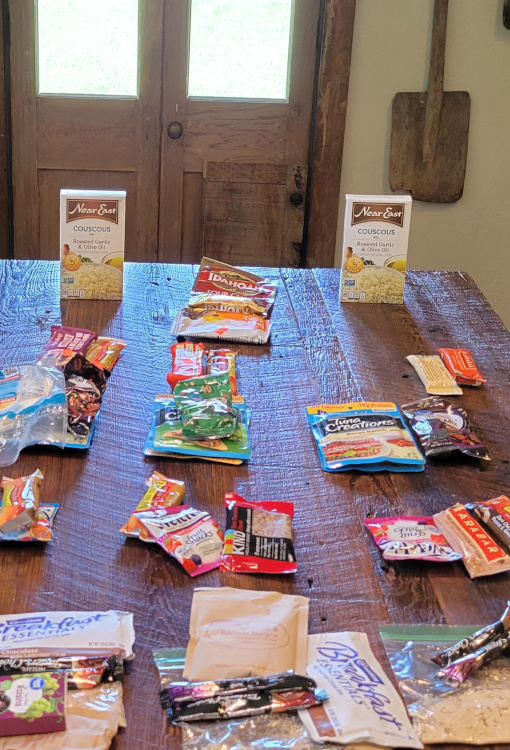
PLAN AHEAD TO STAY ORGANIZED.
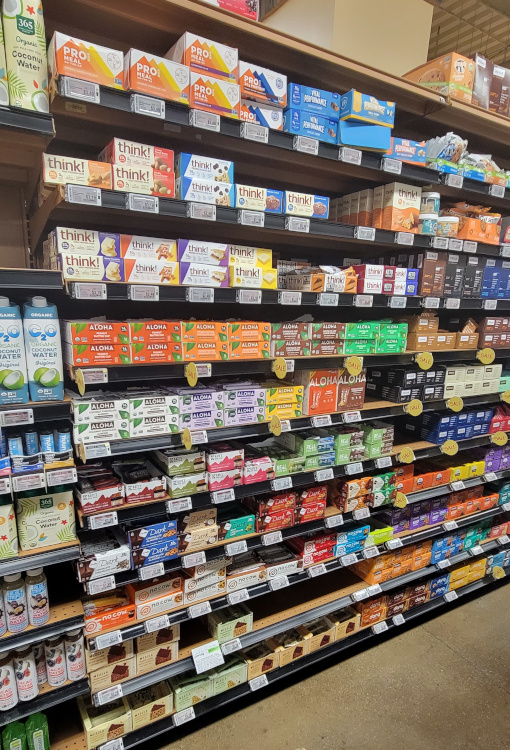
YOU CAN RESUPPLY FROM GROCERY STORES…
RESUPPLY STRATEGIES
Some hikers prefer to send themselves resupply boxes to specific locations, while others rely on purchasing locally available food. Whichever method you choose, make sure it suits your needs and the demands of the trail. Now that you have an idea of what resupplying is, let’s delve into a couple different strategies.
Mail Drops
Some hikers opt for mail drops, where they pre-package and mail supplies to designated post offices or businesses along the trail. This strategy provides control over your food choices but requires careful planning and coordination.
*Pro Tip* When sending packages to yourself on trail, don’t forget to include your NAME, always label your boxes with “HFH” or “HOLD FOR HIKER,” and include your “ETA” or “ESTIMATED DATE OF ARRIVAL.”
PROS: Buying food in bulk beforehand can reduce costs, allows more time in town to explore and rest, and food can be prepared around dietary restrictions.
CONS: Requires more preparation, packages can be expensive to mail (occasionally you have to pay to pick them up too, as much as $20 in some places!). Some post offices only allow you to pick up on the weekday so if you arrive during the weekend, you’d need to stay in town a couple of extra days in order to pick up your package costing extra money.Food fatigue could set in and your appetite could change making the food previously packaged unappealing.
Grocery Stores
Most thru-hikers rely on resupplying at local grocery stores or convenience stores near the trail. This approach allows for flexibility in your food choices, as you can adapt to what’s available. However, occasionally some towns only offer a gas station with a couple hot dogs, 3$ cup of noodles, and a soda fountain- in other words look into what towns you are shooting to visit and take note of their options before you’re stuck with packing out cans of beans for the next 4 days.
PROS:After you get the hang of being on trail it’s easy to know what kind of food works best for your body, there can be more diversity of food in larger towns, and splitting food with fellow hikers can be cheaper and create better trail experiences.
CONS: Some towns are too small to offer sufficient resupplies, it can be hard to find everything you are looking for, it is also easy to overbuy things that aren’t necessary especially in towns that are expensive.
Trail Angels and Hostels(Hiker Boxes)
Many trails have trail angels (those kind souls that provide rides, food, places to stay, etc. for hikers free of charge) or hostels that offer resupply services for hikers. This might look like a small store or the opportunity to send a maildrop. They may also have hiker boxes filled with surplus supplies from previous hikers, providing you with free or discounted food options. A hiker box is a dirtbag treasure trove of extra food or gear that people have left behind. Many times these boxes just accumulate trash as hikers convince themselves that “Someone will want it.” as they leave their damaged and unwanted items behind. But occasionally you’ll find something good. Maybe someone’s resupply box had more than they needed and they left behind unopened tuna packets or oatmeal packets. A great find for anyone running short on food or looking for a supplemental meal.
*Disclaimer* Do not rely on hiker boxes, they are not reliable sources of food and typically meant to fill in gaps of missing food in a supplemental way.
PROS: Free food and gear.
CONS: They aren’t reliable.
TIPS FOR AN EFFICIENT RESUPPLY
To make your resupplying experience smoother, consider the following:
PLAN AHEAD: Research resupply points, store hours, and available food options before starting your hike. Some remote locations may have limited choices. Many popular trails have lists of towns for you to stop and resupply in which can make planning much more convenient.
As an example, here is a link to different towns along the Pacific Crest Trail: PCT RESUPPLY TOWN LOCATIONS.
RESUPPLY LISTS: Create detailed resupply lists with quantities to avoid overpacking or running out of essential items.
LABEL YOUR RESUPPLY BOXES: When mailing resupply packages to yourself on trail, correctly labelling your boxes avoids confusion and helps ensure your package will be there when you arrive to pick it up. On each package, make sure you include your NAME, label your box with “HFH” or “HOLD FOR HIKER,” and include your “ETA” or “ESTIMATED DATE OF ARRIVAL.”
CHECK EXPIRATION DATES: When purchasing items, check expiration dates to ensure your food remains safe to eat throughout your journey. While most resupply points mean well, there have been many instances where some businesses had expired foods in their stores. Always check, and if you’re ok with testing your luck on expired goods, at least negotiate a discount.
LEAVE NO TRACE: Practice Leave No Trace principles when disposing of packaging and trash from your resupply. Carry out what you carry in, this can be easier by carrying out a bag designated for trash.
STAY FLEXIBLE: While planning is crucial, be prepared to adapt your resupply strategy based on trail conditions and unforeseen circumstances. Wild fires might close down a town, a bubble of hikers might clear out all the good food the day before you get into town, anything is possible.

PLANNING AHEAD HELPS AVOID MISTAKES.
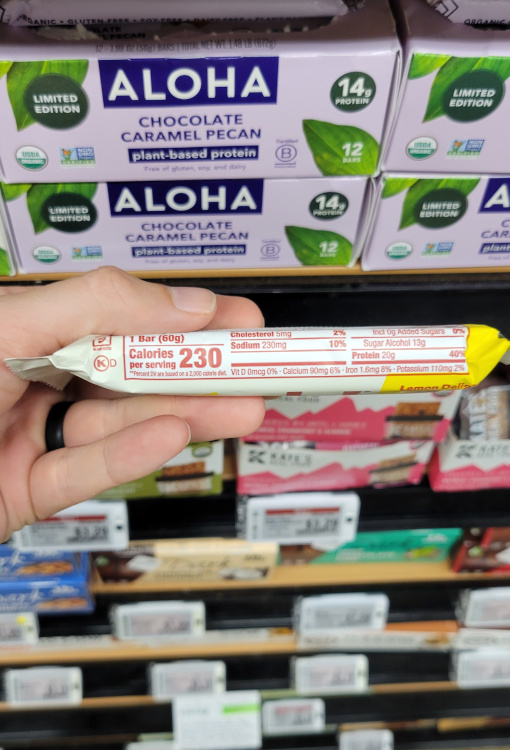
CHOOSE CALORIE + PROTIEN DENSE FOODS.
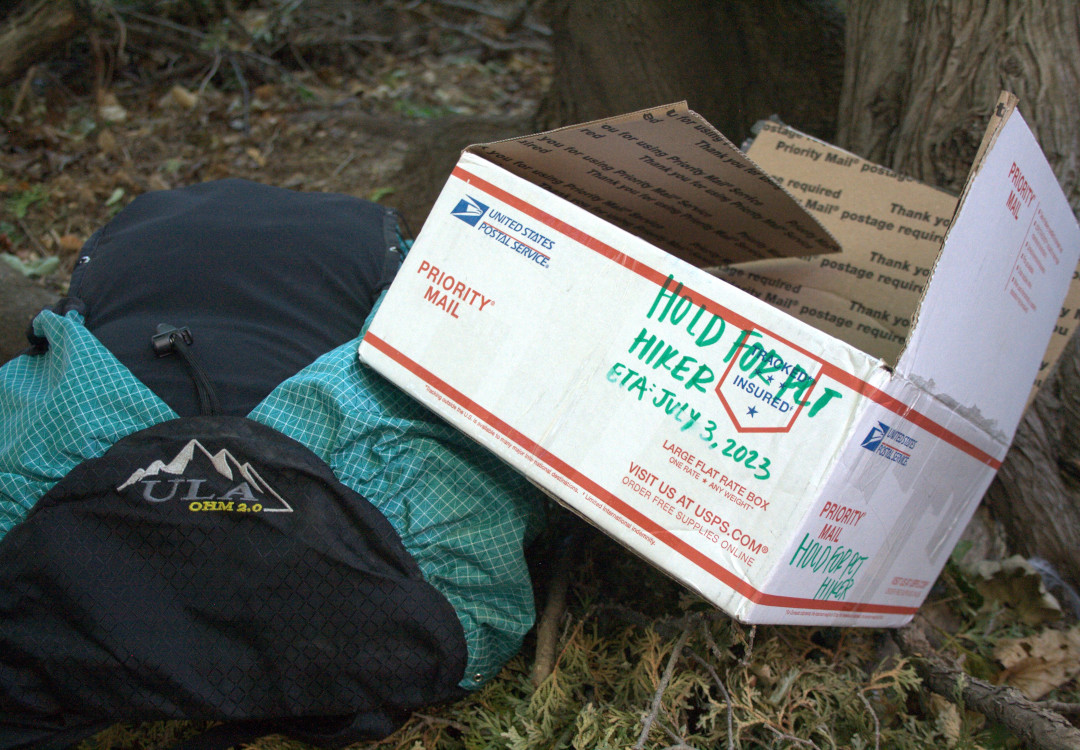
ALWAYS MARK YOUR BOXES WITH YOUR NAME, “HOLD FOR HIKER” & YOUR ETA.
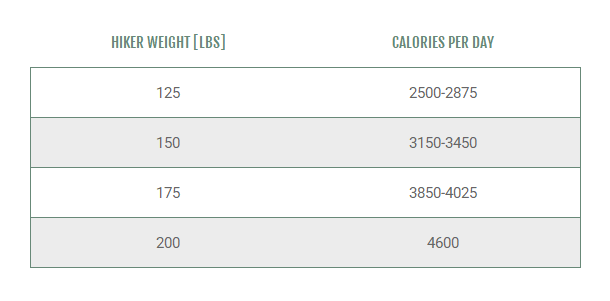
CHART 1. CALCULATING YOUR CALORIE NEEDS BY BODY WEIGHT
Understanding Resupply Points
Before you hit the trail, it’s important to map out or note your resupply points. These are predetermined locations along the trail where you’ll restock your provisions. Sometimes they’re full sized towns with multiple store options, sometimes they’re a single gas station or small convenience store. They can vary in distance, with some trails having resupply points every few days, while others may have longer stretches between them. Knowing where these points are is crucial for planning your daily mileage and managing your food supply.
Keep in mind that every trail will have its own little flare, meaning you may have to learn how to resupply in different ways depending on what you’re hiking. The Appalachian Trail comes into contact with towns more frequently than The Pacific Crest or The Continental Divide in most sections- while it may be more forgiving in strategy it can be easier to overspend a budget. The Pacific Crest Trail has less resupply stops the closer north a hiker is. Stehekin is a town along the PCT that is only accessible by foot, plane, or boat; this town only offers one grocery store with expensive ramen and few options, so if not well planned it would be an inconvenient place to try and find all your favorites.
Calculate Your Food Needs
Estimating your daily caloric needs can be monumentally game changing in the resupply world.
Instead of running around a store frantically trying to fill your pack, you can measure what food would be best based on how many calories are in every ounce and how many calories you expect to eat. Keep in mind the duration between resupply points. This will give you a rough idea of how much food you need to carry between resupplies. Always add a buffer to account for unexpected delays or changes in your hiking pace.
Also take note that typically toward the start of trail the “hiker hunger” hasn’t quite set in and it can your body won’t have the same caloric needs as it will later in the trail. Don’t stress about that for the first couple of weeks, without a doubt your appetite will come.
Many factors go into how many calories a hiker burns while backpacking. Living at higher elevation will put more strain on your body which burns through calories rapidly. If you’re hiking with a higher pack weight then it will also require more energy. Look ahead at what you will be hiking, our “Calculating Your Calorie Needs By Weight” chart is a basic rule of thumb to for calorie consumption by body weight while hiking.
How Do I Know What Food is Right?
Choosing the right backpacking food is essential for maintaining your energy levels and enjoying your journey. When selecting food items, consider the following factors:
CALORIC DENSITY: Opt for foods that provide at least 115-125 of calories per ounce. A general rule of thumb is to aim for around 3,000-5,000 calories per day, depending on factors like your weight, hiking pace, and the terrain. This helps you pack more energy into your backpack without adding excessive weight. Some great options include nuts, nut butter, cheese, granola bars, and dehydrated meals.
NUTRIENT VARIETY: A balanced diet is crucial for long-distance hiking. Ensure your food choices include a mix of carbohydrates, proteins, and fats. Incorporate a variety of foods like whole grains, dried fruits, jerky, and dehydrated vegetables to meet your nutritional needs. Tuna or chicken packets may be heavier than some lighter options, but they’re great sources of protein.
MEAL PLANNING: Plan your meals in advance to ensure you have a balanced diet. Aim for variety to prevent food fatigue- imagine eating oatmeal 3X daily for 2 weeks straight, chances are you’ll want to change things up. Break your meals into breakfast, lunch, dinner, and snacks, and consider dietary restrictions or preferences.
PACKAGING: Choose foods with minimal packaging, instead of keeping a ton of different ingredients separated, put them together to reduce waste on the trail. Repackaging items into reusable containers or ziplock bags can also save space and weight.
Cleaning dishes can be a tedious chore while at camp, instead of cooking everything in a pot try using freezer bags or steaming your food in a reusable bag. Knorr’s pasta sides and instant potatoes offer packaging that makes cooking food inside possible.
A Final Word
For all those thru-hikers and section hikers out there remember that resupplying is a fundamental aspect to making sure you’re successful on your journey. Everyone has a different approach and you may need to try out a couple different things before you know what is right for you. With a well-planned resupply strategy and the best backpacking food in your pack, you’ll be well-equipped to make your long-distance hiking dreams a reality. Good luck on your next or upcoming adventure, may your resupply points always be well-stocked, and we’ll see you down the trail!


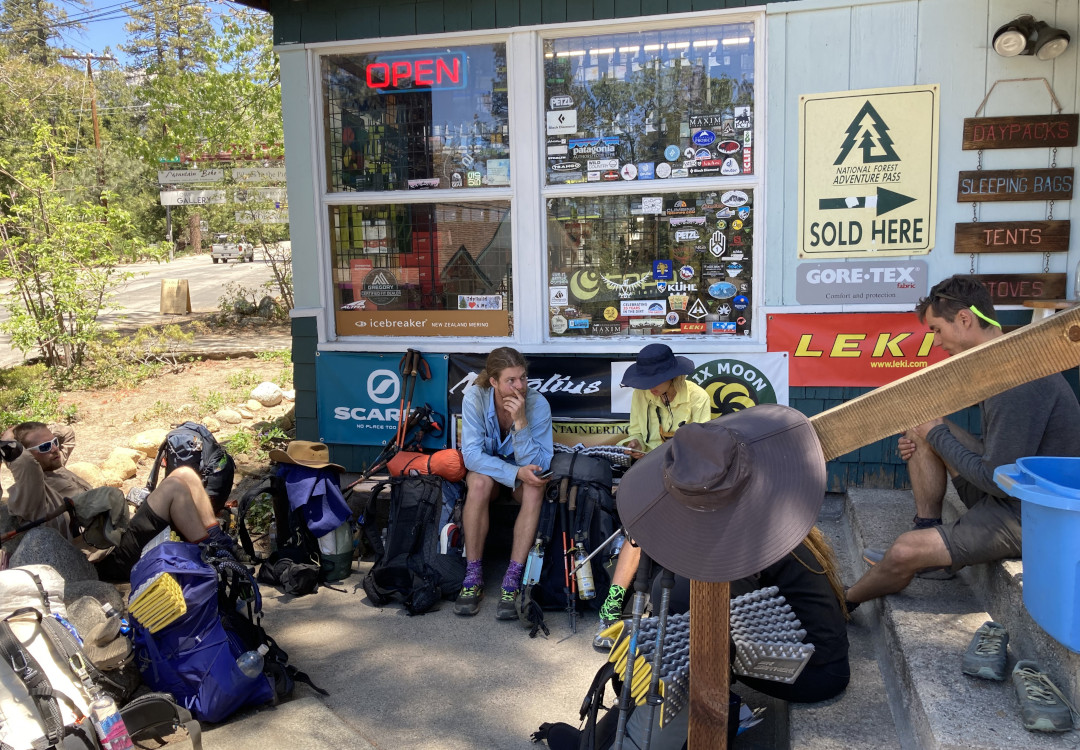
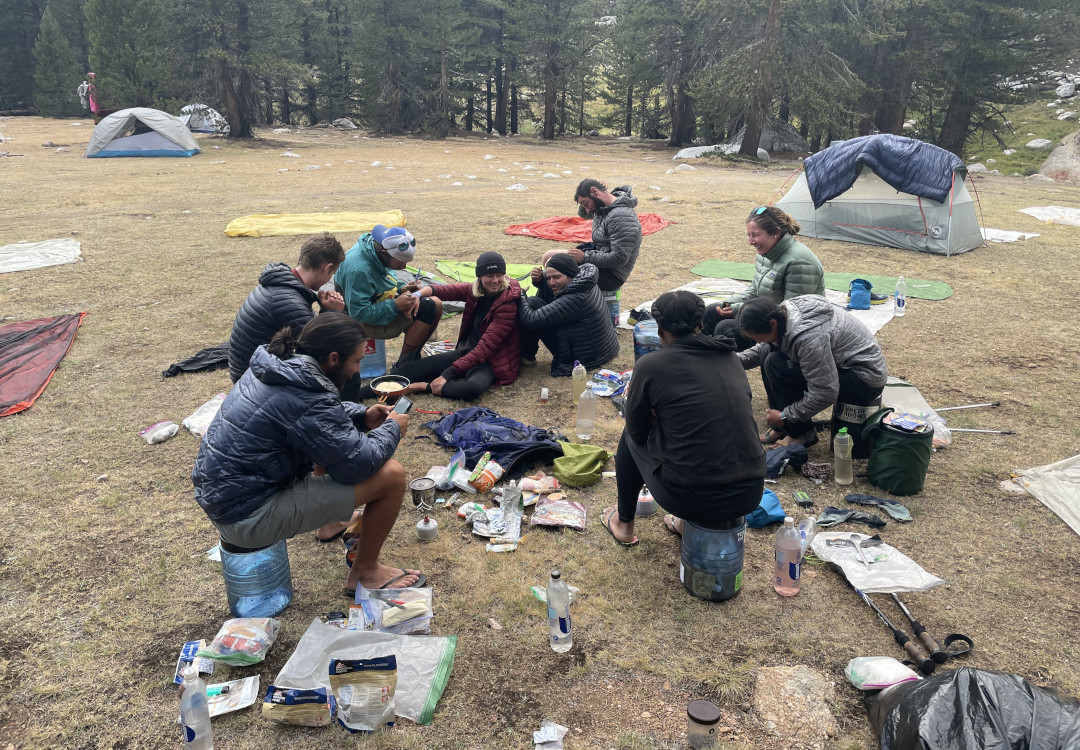
Thank you for this very informative article about resupplying on the trail. Being a somewhat experienced long distance hiker, I have used a variety of all the methods discussed here. Except recently I have considered another method which will save money on shipping to areas where resupply boxes are sent. I’m thinking that walmrt.com and amazon.com offer free shipping with minimum orders which isn’t hard to meet when ordering trail foods, in time to have Walmart or Amazon orders shipped to meet me ahead on the trail. That saves mailing costs. It’s just a matter of researching ahead and ordering in sufficient time.